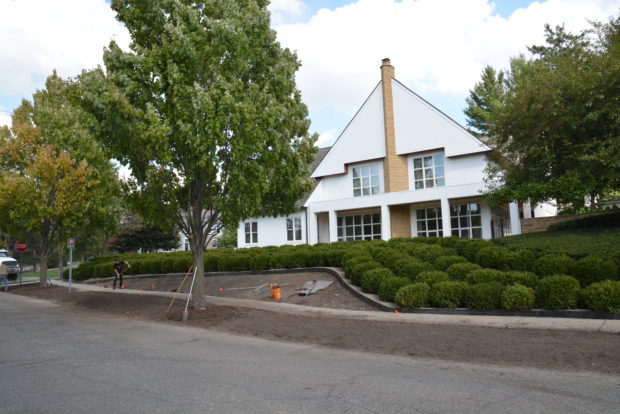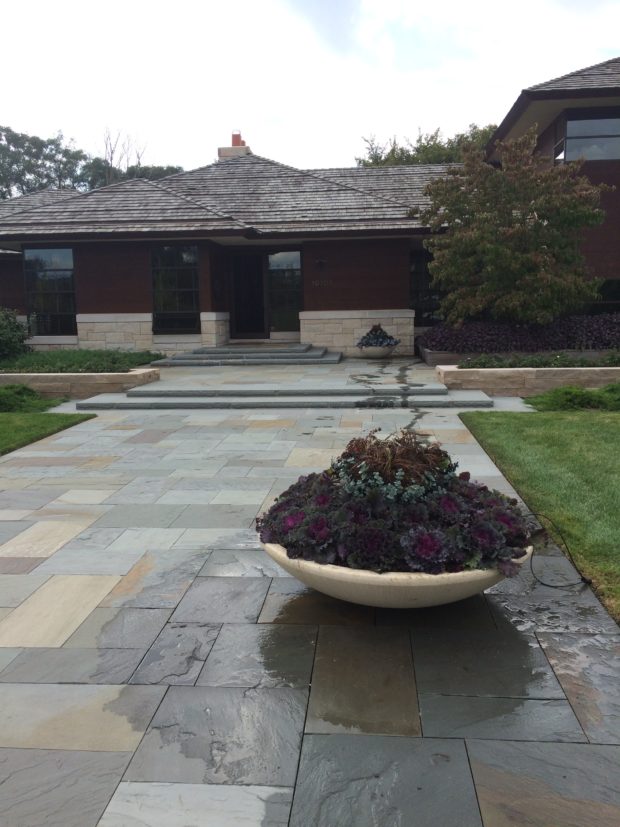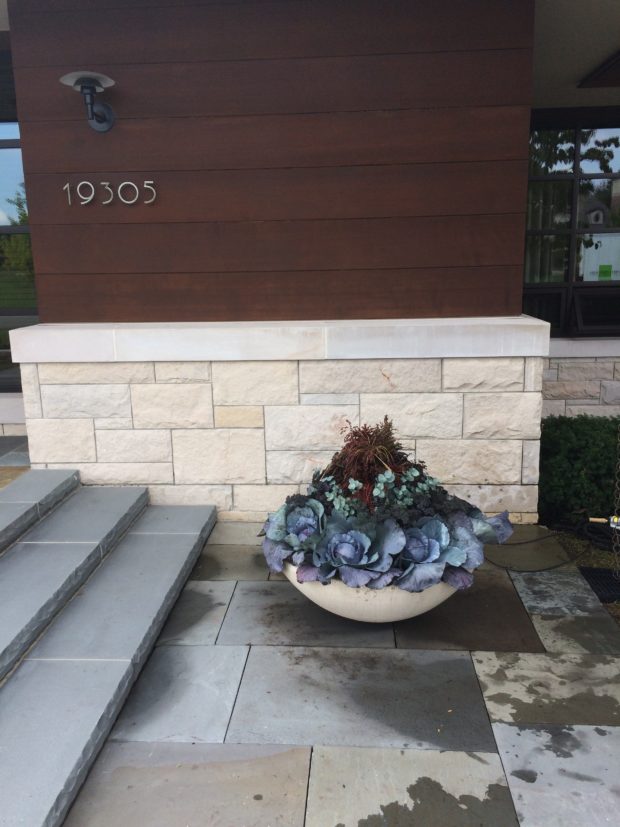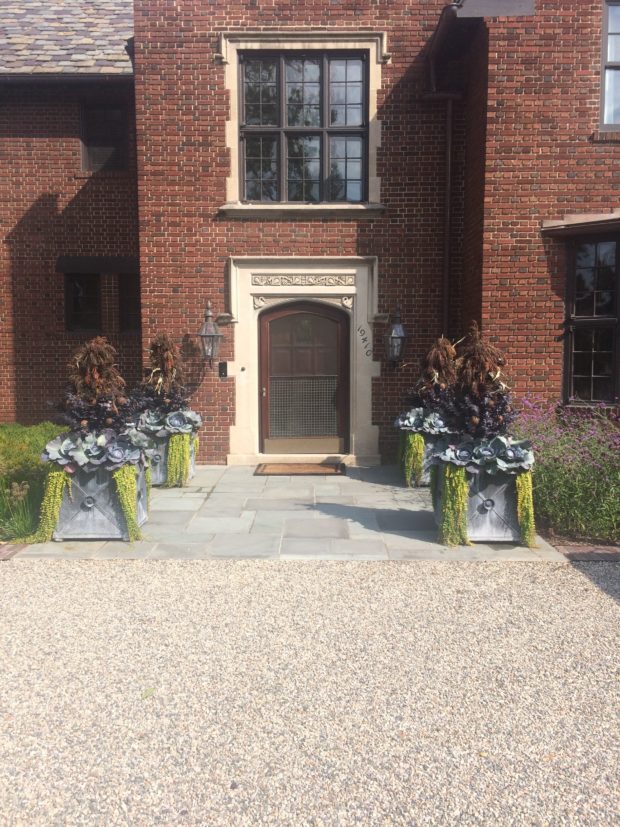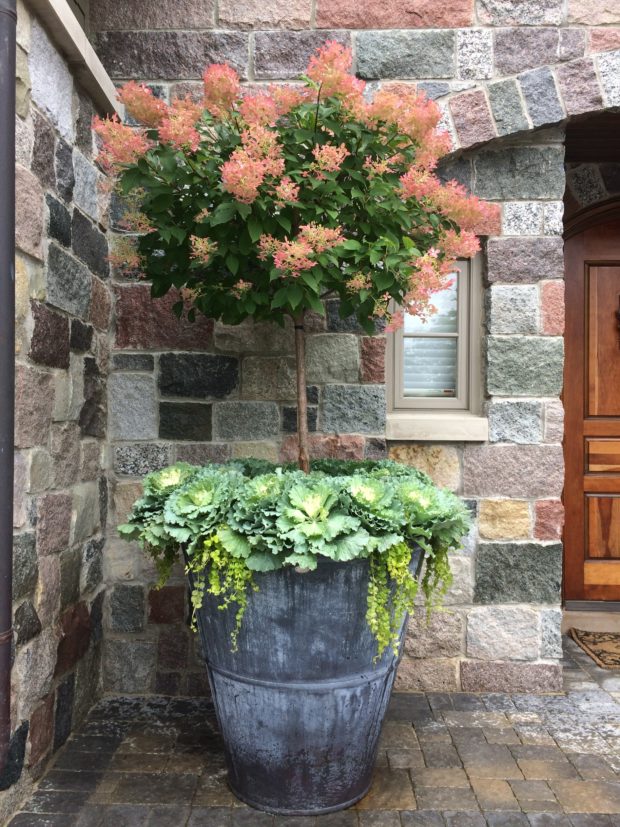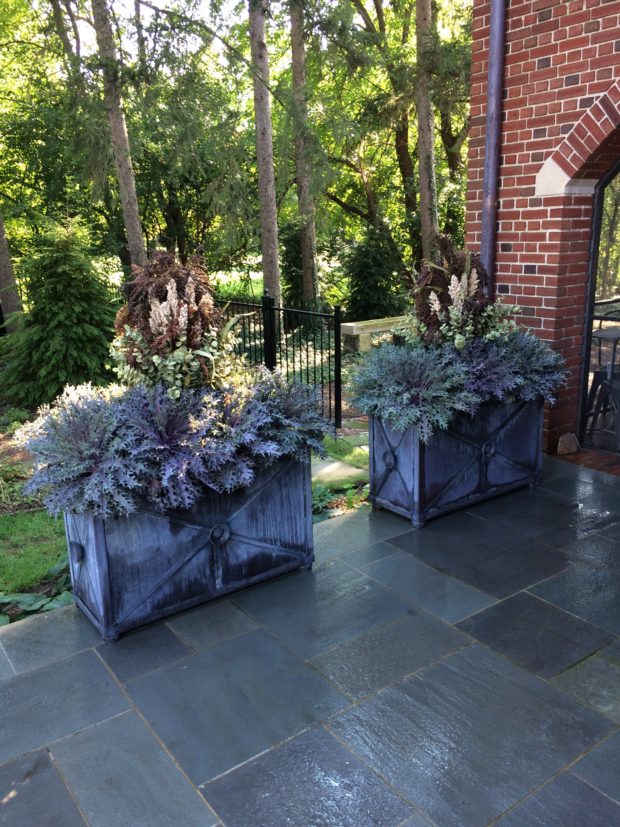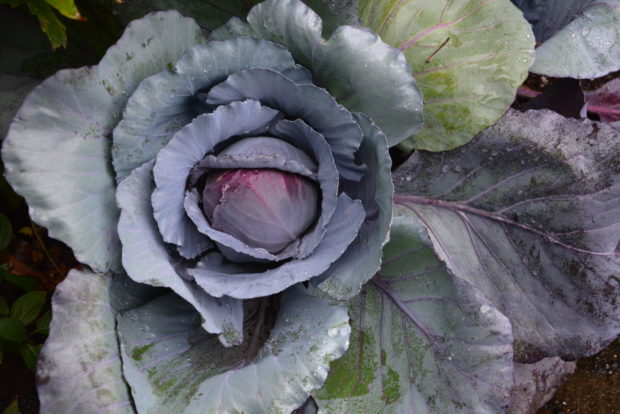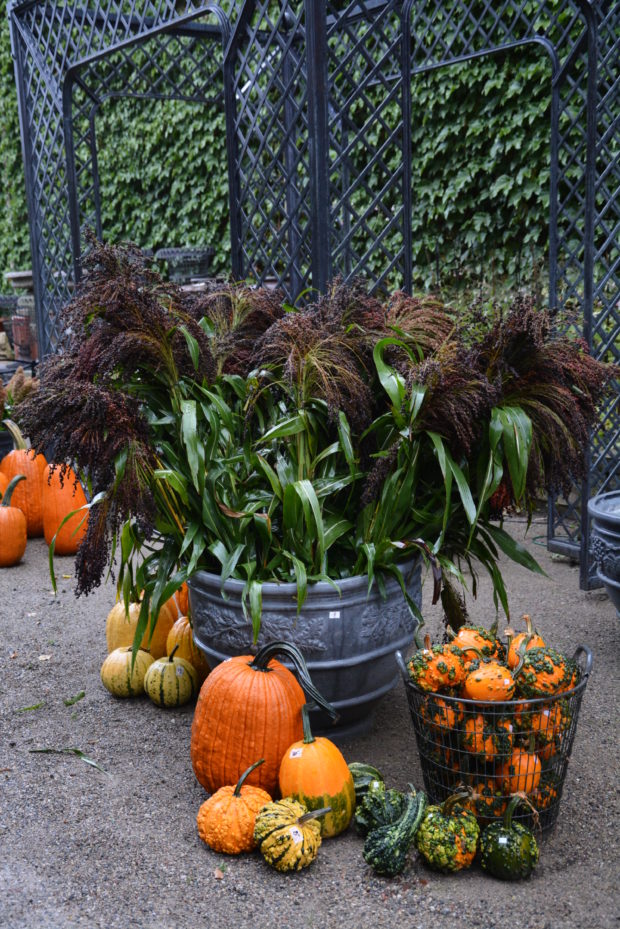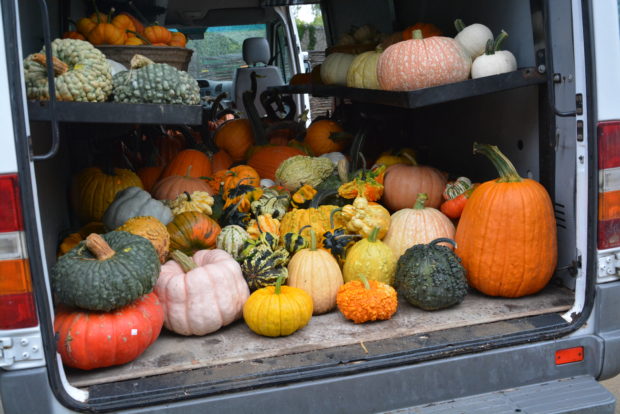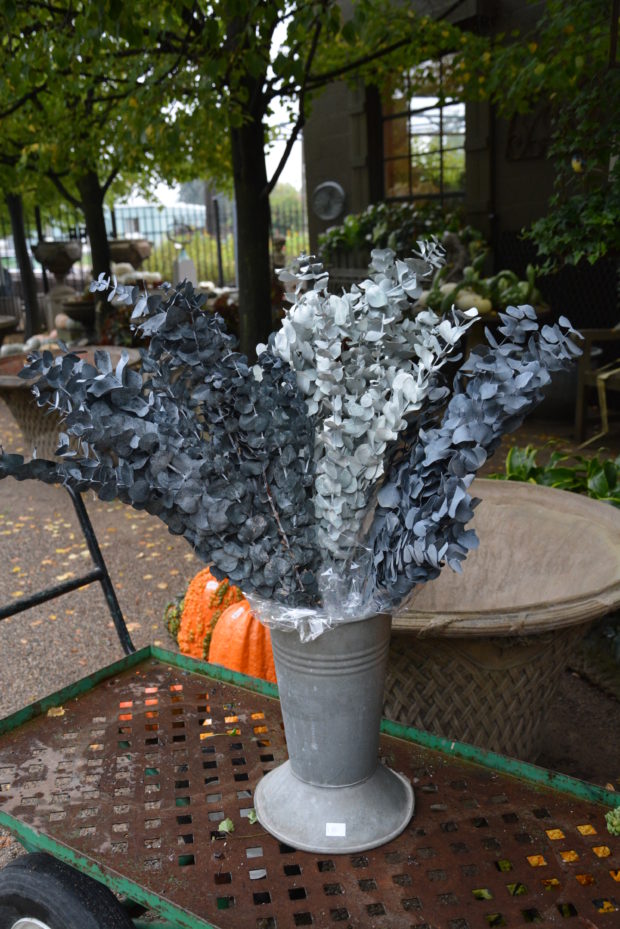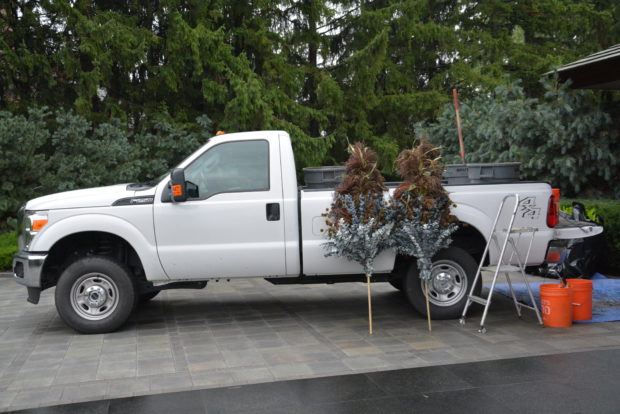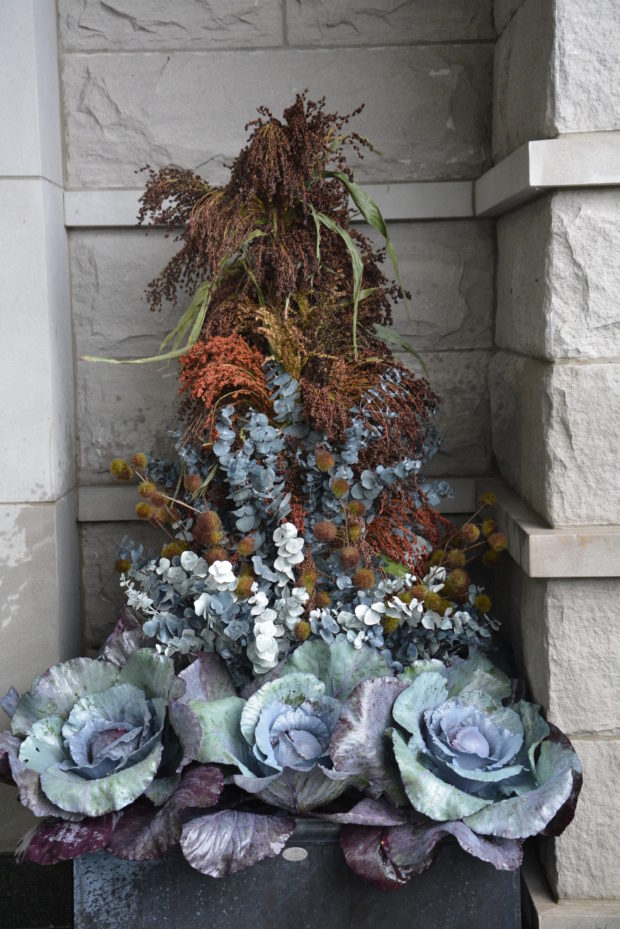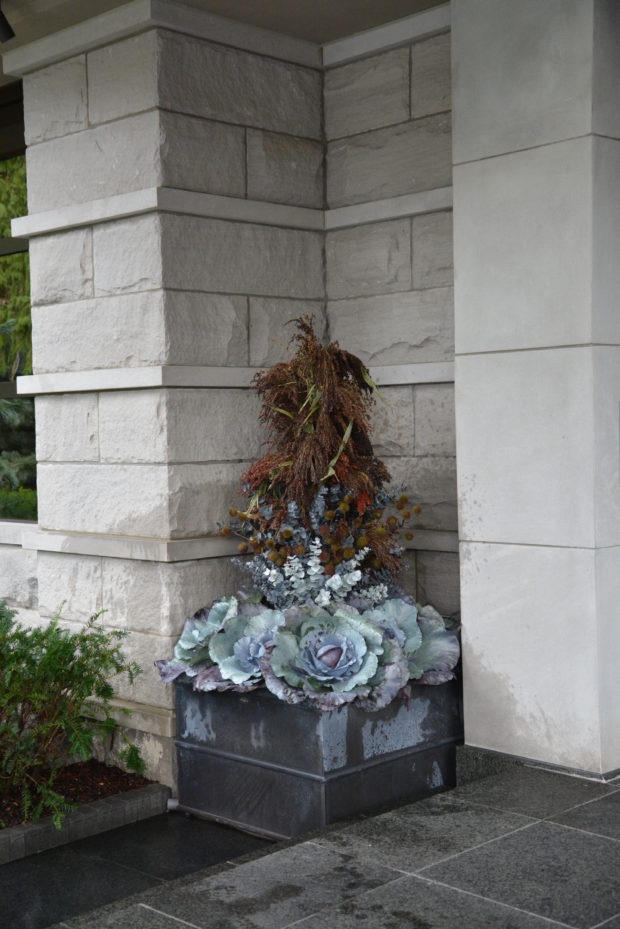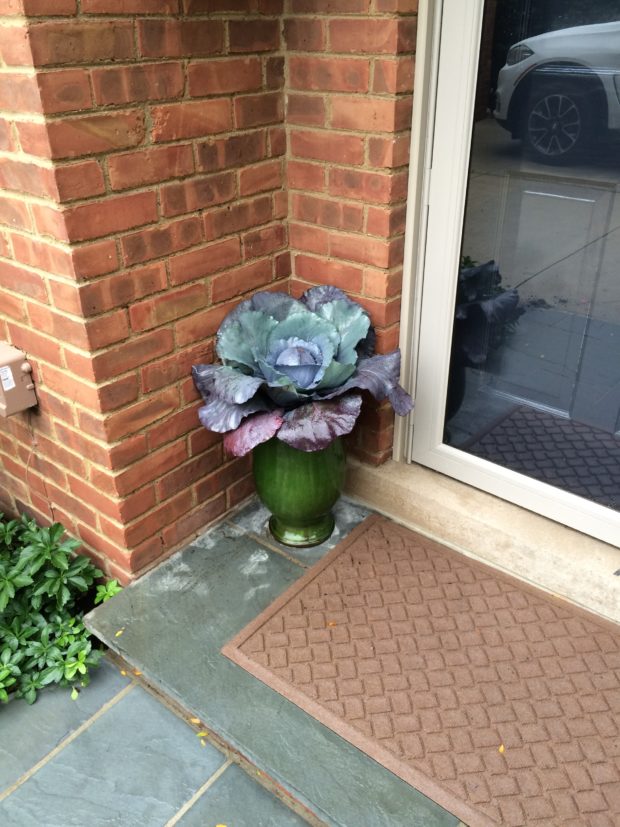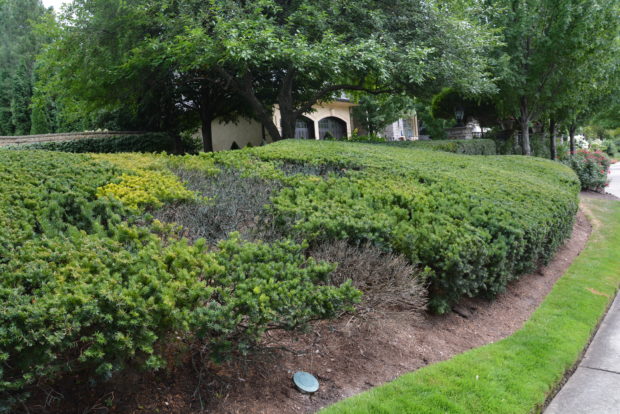 My clients own a contemporary home situated on a compact property in an urban neighborhood. The house (not visible in this picture) sits a good three feet above the sidewalk. Though I had helped with the landscape design in immediate proximity to the front door, an L-shaped planting of yews mirroring the sidewalks of their corner property predated my work with them. The above picture shows part of a collection of yews planted on that slope, that had suffered from years of too much irrigation water, and poor pruning. Too much water can be deadly to evergreens – especially yews. The massed planting meant that I did not have a clear picture of the grade or the dimensions of the area to be landscaped. I told my clients that I would have to remove all of the yews prior to having a redesign of this part of their landscape. They agreed to the removal, with no clear idea of where we would go next. They indicated that they had trust in my eye, and that I should go ahead.
My clients own a contemporary home situated on a compact property in an urban neighborhood. The house (not visible in this picture) sits a good three feet above the sidewalk. Though I had helped with the landscape design in immediate proximity to the front door, an L-shaped planting of yews mirroring the sidewalks of their corner property predated my work with them. The above picture shows part of a collection of yews planted on that slope, that had suffered from years of too much irrigation water, and poor pruning. Too much water can be deadly to evergreens – especially yews. The massed planting meant that I did not have a clear picture of the grade or the dimensions of the area to be landscaped. I told my clients that I would have to remove all of the yews prior to having a redesign of this part of their landscape. They agreed to the removal, with no clear idea of where we would go next. They indicated that they had trust in my eye, and that I should go ahead.
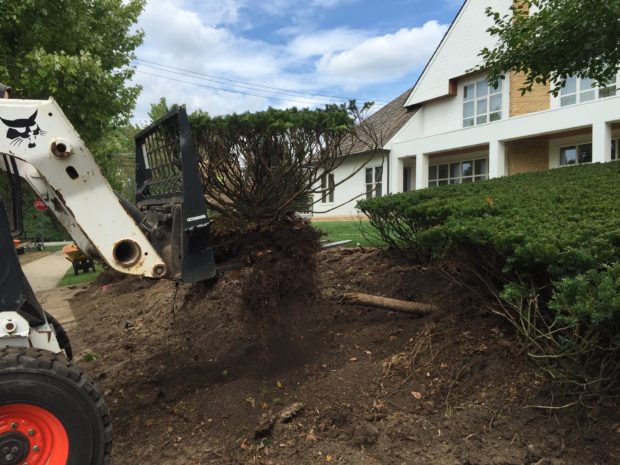 The yews that still had decent root systems had been pruned within an inch of their lives. The above picture is telling. Pruning spreading yews (taxus densiformis and its associated cultivars) flat with a power operated pruning tool results in a shallow but dense layer of top growth that denies air, light, and water, to the branches below. Every pruning cut produces a multitude of breaks in any woody plant stem. This yew, like every other one we removed, had an uppermost skin of green supported by a thicket of bare branches. Yews need to be pruned casually, and irregularly. Like a shag haircut. If you are interested in an upright and formally growing yew, choose one that has a naturally formal habit that approximates what you need-as in taxus media “Moonii”. But I digress. Any yew branch, no matter how thick or old, will sprout needles given enough light. These lower branches lost their light a long time ago, and would take many years to re-needle.
The yews that still had decent root systems had been pruned within an inch of their lives. The above picture is telling. Pruning spreading yews (taxus densiformis and its associated cultivars) flat with a power operated pruning tool results in a shallow but dense layer of top growth that denies air, light, and water, to the branches below. Every pruning cut produces a multitude of breaks in any woody plant stem. This yew, like every other one we removed, had an uppermost skin of green supported by a thicket of bare branches. Yews need to be pruned casually, and irregularly. Like a shag haircut. If you are interested in an upright and formally growing yew, choose one that has a naturally formal habit that approximates what you need-as in taxus media “Moonii”. But I digress. Any yew branch, no matter how thick or old, will sprout needles given enough light. These lower branches lost their light a long time ago, and would take many years to re-needle.
 I understood my client’s interest that this slope be planted. Their property is across the street from a busy city park. They loved overlooking the park, but they wanted some small measure of privacy. Once the yews were removed, I got a good look at the lay of the land. The grass on the upper level had an irregular edge, and sloped downward to the corner. The slope itself sagged in the middle. The yews that had been planted next to the foundation of the house-we got rid of them. Those Hicks yews obscured the beautiful stone foundation of the house, and had grown up over the bottoms of the windows. Any element in a landscape that is overgrown says untended loud and clear. My clients were ready to redo. We did the best we could to level the upper lawn plane, with a plan to grass up to that stone foundation.
I understood my client’s interest that this slope be planted. Their property is across the street from a busy city park. They loved overlooking the park, but they wanted some small measure of privacy. Once the yews were removed, I got a good look at the lay of the land. The grass on the upper level had an irregular edge, and sloped downward to the corner. The slope itself sagged in the middle. The yews that had been planted next to the foundation of the house-we got rid of them. Those Hicks yews obscured the beautiful stone foundation of the house, and had grown up over the bottoms of the windows. Any element in a landscape that is overgrown says untended loud and clear. My clients were ready to redo. We did the best we could to level the upper lawn plane, with a plan to grass up to that stone foundation.
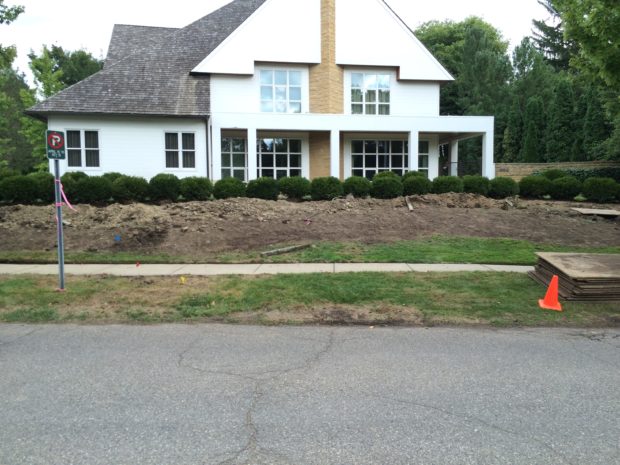 Just prior to my client’s call for a landscape renovation, I had a call from a supplier about a field of 40″ diameter Green Gem boxwood available for sale. I sent pictures to my clients. They were indeed interested. All three of us could see that these beautiful plants could could go a long way towards a sculptural landscape for this property. I arranged to have the boxwood delivered.
Just prior to my client’s call for a landscape renovation, I had a call from a supplier about a field of 40″ diameter Green Gem boxwood available for sale. I sent pictures to my clients. They were indeed interested. All three of us could see that these beautiful plants could could go a long way towards a sculptural landscape for this property. I arranged to have the boxwood delivered.
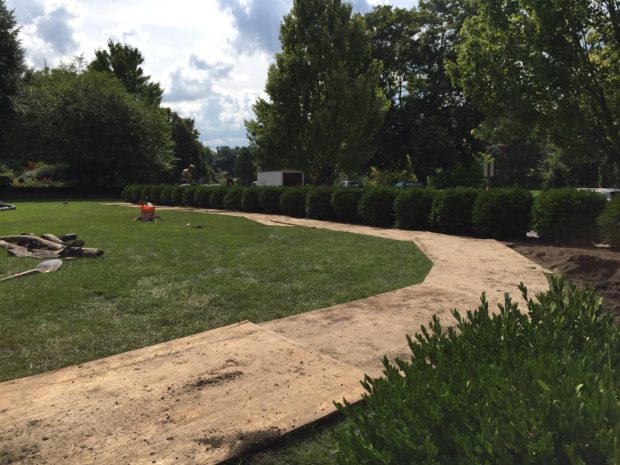 We did a lot of work to restore the upper level surrounding the house to a reasonably flat plane. That took in excess of 20 yards of soil. Many yards of that soil went to that low corner in the center far right of this picture. We laid down a roadway of plywood. We had no idea to damage that upper level grass, but we had heavy plants to move. The first row of these giant boxwood were planted with an eye to celebrating the newly leveled plane up top. Thought these boxwood were remarkably uniform, there were subtle differences. The arrangement of the plants in a row took a little time to get right.
We did a lot of work to restore the upper level surrounding the house to a reasonably flat plane. That took in excess of 20 yards of soil. Many yards of that soil went to that low corner in the center far right of this picture. We laid down a roadway of plywood. We had no idea to damage that upper level grass, but we had heavy plants to move. The first row of these giant boxwood were planted with an eye to celebrating the newly leveled plane up top. Thought these boxwood were remarkably uniform, there were subtle differences. The arrangement of the plants in a row took a little time to get right.
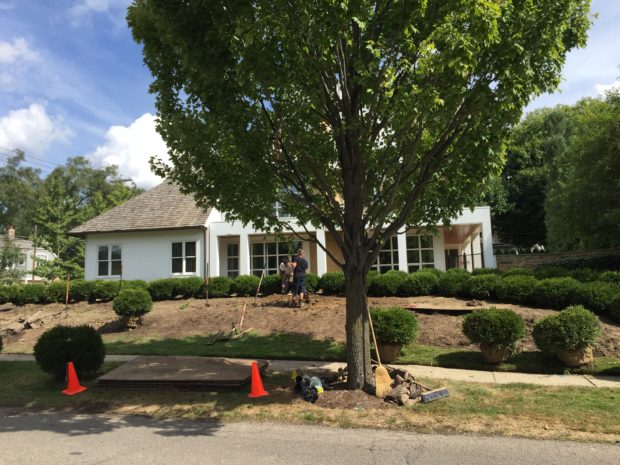 The early view from the street was chaotic. Several iterations of previous sprinkler systems, and a complex drainage field was hidden underground. Rearranging and adding to pipe and drainage stone was a tedious but necessary part of the project.
The early view from the street was chaotic. Several iterations of previous sprinkler systems, and a complex drainage field was hidden underground. Rearranging and adding to pipe and drainage stone was a tedious but necessary part of the project.
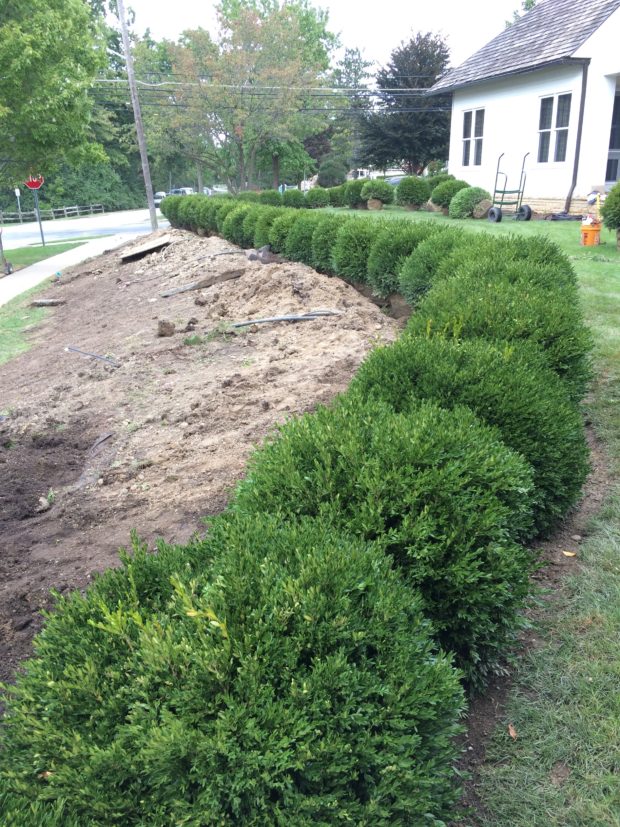 This first row of boxwood took the longest to set, as it would establish the direction and height for all of the other plants to come.
This first row of boxwood took the longest to set, as it would establish the direction and height for all of the other plants to come.
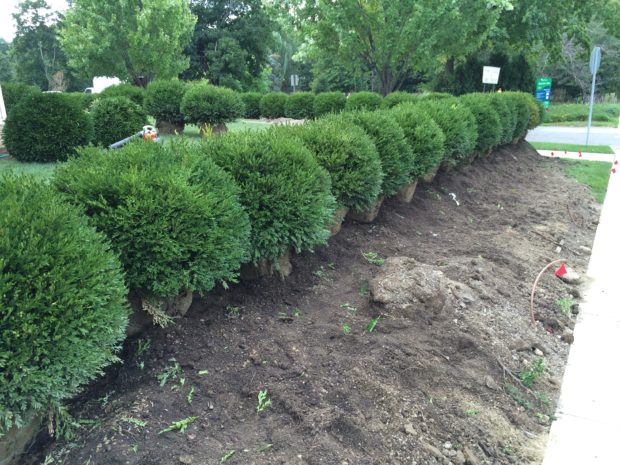 The boxwood placed on the opposite side were were set very high, to maintain the level established at the top. The root balls of the second row to come would act like a retaining wall that would permit back filling around the plants in the first row. Each of these boxwood has a root ball 28″ in diameter. Those root balls would act like a wall, and would help prevent soil erosion.
The boxwood placed on the opposite side were were set very high, to maintain the level established at the top. The root balls of the second row to come would act like a retaining wall that would permit back filling around the plants in the first row. Each of these boxwood has a root ball 28″ in diameter. Those root balls would act like a wall, and would help prevent soil erosion.
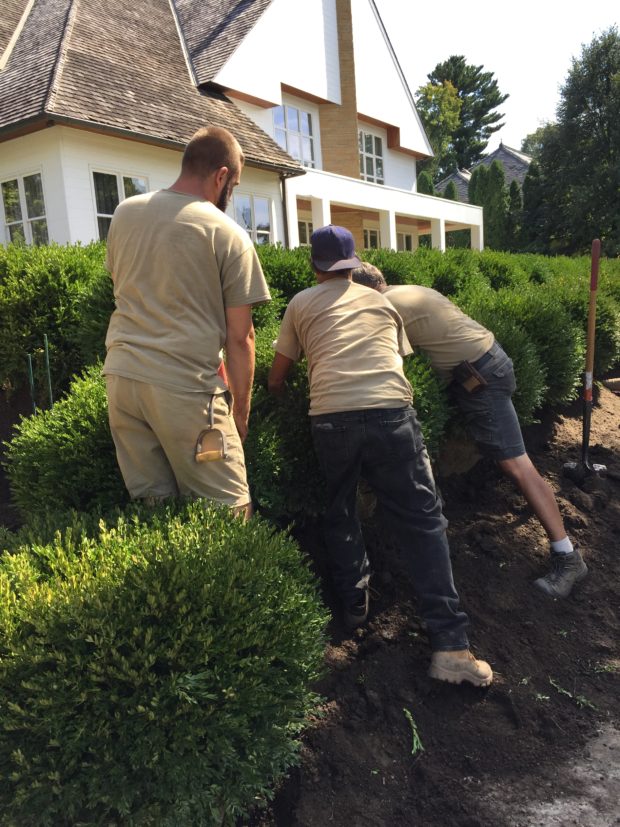 It took the better part of an hour to face and plant each of the boxwood. The weight and the bulk of each plant made them difficult to handle.
It took the better part of an hour to face and plant each of the boxwood. The weight and the bulk of each plant made them difficult to handle.
 The original slope was dishy and rolling. Prior to planting each row, we regraded the soil so it was dropping down towards the walk at a uniform rate. Each succeeding row of boxwood dropped down a corresponding amount. Or as least as close to a uniformly corresponding as was possible with boxwood of this size.
The original slope was dishy and rolling. Prior to planting each row, we regraded the soil so it was dropping down towards the walk at a uniform rate. Each succeeding row of boxwood dropped down a corresponding amount. Or as least as close to a uniformly corresponding as was possible with boxwood of this size.
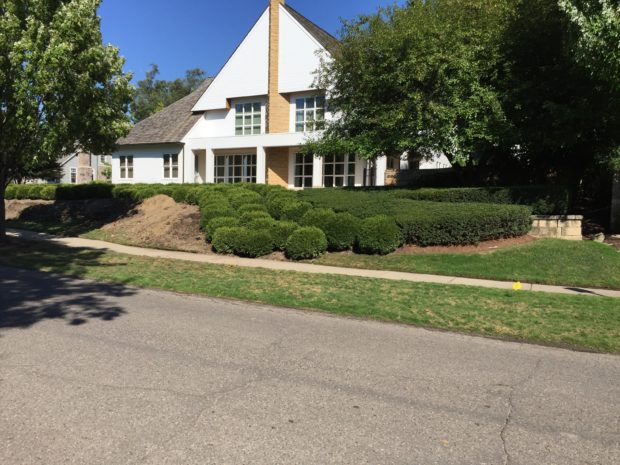 The yews on the far south side were not only healthy, they were beautiful. They occupied a very large area on both the upper and the lower level. We kept them. We would snug the south side of the rows of boxwood up tight to to these existing yews.
The yews on the far south side were not only healthy, they were beautiful. They occupied a very large area on both the upper and the lower level. We kept them. We would snug the south side of the rows of boxwood up tight to to these existing yews.
 Once the first two rows were planted, it was time to set the corner. The flow of the rows depended on establishing the corner plants. My rough sketch to my client is not my usual presentation. In lieu of accurate drawings, we talked. One row at a time.
Once the first two rows were planted, it was time to set the corner. The flow of the rows depended on establishing the corner plants. My rough sketch to my client is not my usual presentation. In lieu of accurate drawings, we talked. One row at a time.
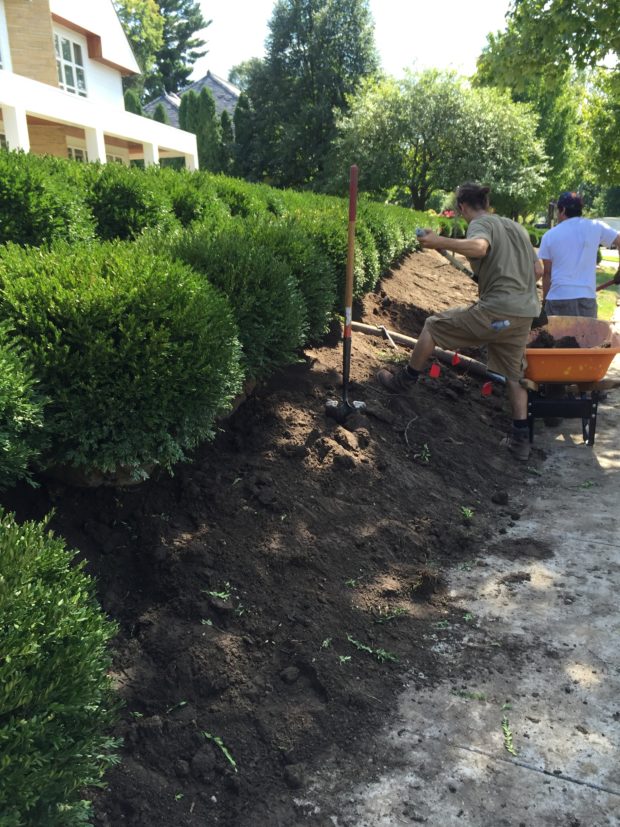 Each arm of row three began at the corner, and radiated out. Once we had four rows planted on the west side, and three rows planted on the north, we were ready for edger strip. A drip irrigation system was installed by Ian Edmunds Irrigation to insure that each boxwood would get water directly to the roots. He is the most thoughtful and thorough irrigation contractor it has ever been my pleasure to work with. The edger strip?
Each arm of row three began at the corner, and radiated out. Once we had four rows planted on the west side, and three rows planted on the north, we were ready for edger strip. A drip irrigation system was installed by Ian Edmunds Irrigation to insure that each boxwood would get water directly to the roots. He is the most thoughtful and thorough irrigation contractor it has ever been my pleasure to work with. The edger strip?
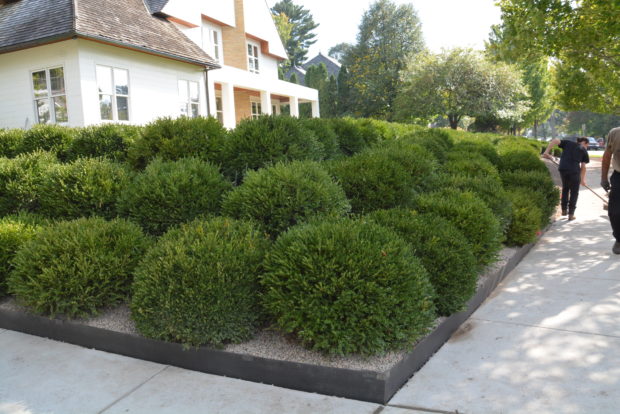 This oversized steel edging would allow us to back fill the bottom row of boxwood with soil, and mulch the front row of boxwood with gravel.
This oversized steel edging would allow us to back fill the bottom row of boxwood with soil, and mulch the front row of boxwood with gravel.
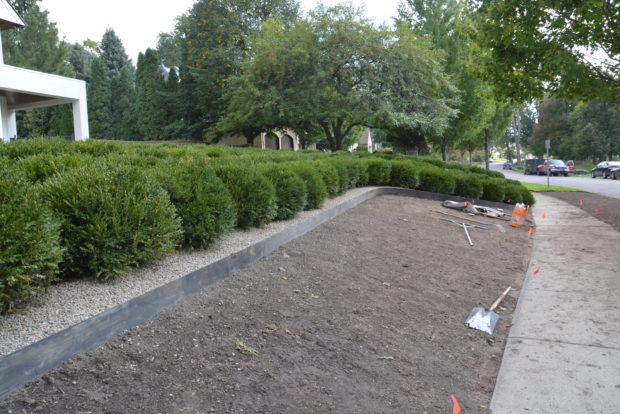 The tall steel edger strip solved a multitude of problems that were presented by this steep slope.
The tall steel edger strip solved a multitude of problems that were presented by this steep slope.
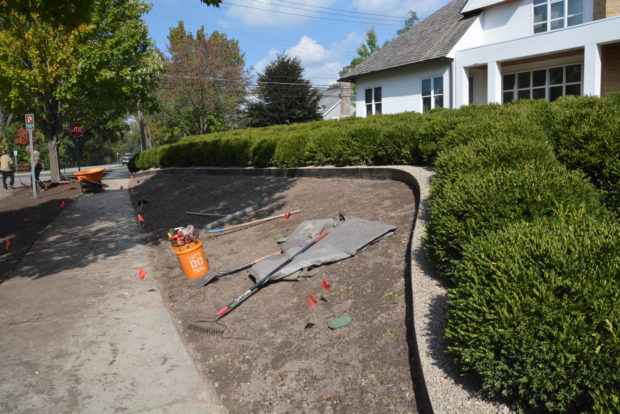 The grass to come on this slope would connect visually with the grass in the tree lawn.
The grass to come on this slope would connect visually with the grass in the tree lawn.
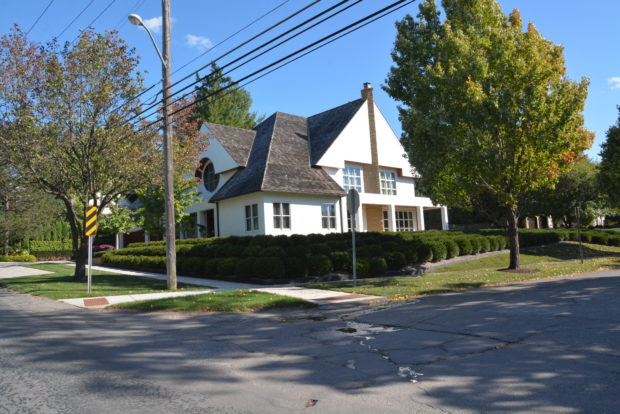 the finished project from the intersection
the finished project from the intersection
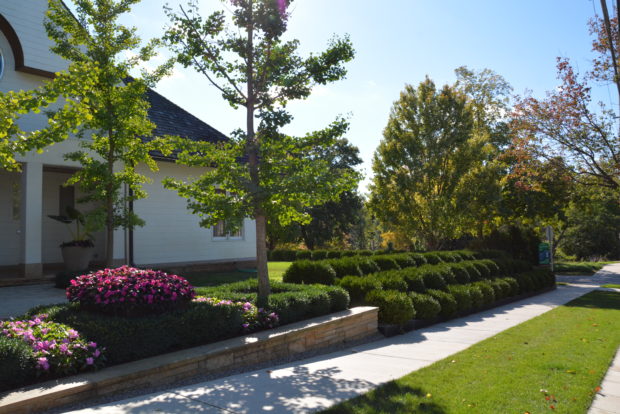 The north side part of this landscape renovation looks good to me, and my clients. This very sculptural landscape is all about an incredibly beautiful collection of boxwood. Sometimes the plants drive the design.
The north side part of this landscape renovation looks good to me, and my clients. This very sculptural landscape is all about an incredibly beautiful collection of boxwood. Sometimes the plants drive the design.
